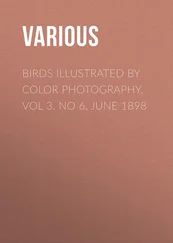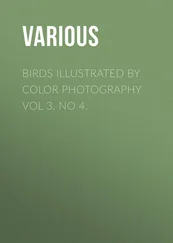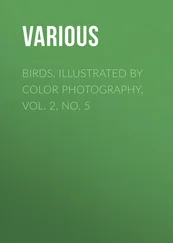Various - Birds Illustrated by Color Photography [February, 1898]
Здесь есть возможность читать онлайн «Various - Birds Illustrated by Color Photography [February, 1898]» — ознакомительный отрывок электронной книги совершенно бесплатно, а после прочтения отрывка купить полную версию. В некоторых случаях можно слушать аудио, скачать через торрент в формате fb2 и присутствует краткое содержание. Жанр: periodic, Биология, Природа и животные, foreign_edu, на английском языке. Описание произведения, (предисловие) а так же отзывы посетителей доступны на портале библиотеки ЛибКат.
- Название:Birds Illustrated by Color Photography [February, 1898]
- Автор:
- Жанр:
- Год:неизвестен
- ISBN:нет данных
- Рейтинг книги:3 / 5. Голосов: 1
-
Избранное:Добавить в избранное
- Отзывы:
-
Ваша оценка:
- 60
- 1
- 2
- 3
- 4
- 5
Birds Illustrated by Color Photography [February, 1898]: краткое содержание, описание и аннотация
Предлагаем к чтению аннотацию, описание, краткое содержание или предисловие (зависит от того, что написал сам автор книги «Birds Illustrated by Color Photography [February, 1898]»). Если вы не нашли необходимую информацию о книге — напишите в комментариях, мы постараемся отыскать её.
Birds Illustrated by Color Photography [February, 1898] — читать онлайн ознакомительный отрывок
Ниже представлен текст книги, разбитый по страницам. Система сохранения места последней прочитанной страницы, позволяет с удобством читать онлайн бесплатно книгу «Birds Illustrated by Color Photography [February, 1898]», без необходимости каждый раз заново искать на чём Вы остановились. Поставьте закладку, и сможете в любой момент перейти на страницу, на которой закончили чтение.
Интервал:
Закладка:
Various
Birds Illustrated by Color Photography [February, 1898] / A Monthly Serial designed to Promote Knowledge of Bird-Life
GILBERT WHITE AND “SELBORNE.”
I SUPPOSE that a habit of minute observation of nature is one of the most difficult things to acquire, as it is one which is less generally pursued than any other study. In almost all departments of learning and investigation there have been numberless works published to illustrate them, and text books would fill the shelves of a large library. Thoreau in his “Walden” has shown an extremely fine and close observation of the scenes in which his all too short life was passed, but his object does not seem at any time to have been the study of nature from an essential love of it, or to add to his own or the world’s knowledge. On the contrary, nature was the one resource which enabled him to exemplify his notions of independence, which were of such a sturdy and uncompromising character that Mr. Emerson, who had suffered some inconvenience from his experience of Thoreau as an inmate of his household, thought him fitter to meet occasionally in the open air than as a guest at table and fireside. There is a delicious harmony with nature in all that he has written, but his descriptions of out-of-door life invite us rather to indolent musing than to investigation or study. Who after reading Izaak Walton ever went a-fishing with the vigor and enterprise of Piscator? Washington Irving allowed his cork to drift with the current and lay down in the shadow of a spreading oak to dream with the beloved old author.
In White’s “Natural History of Selborne” we have a unique book indeed, but of a far more general interest than its title would indicate. Pliny, the elder, was the father of natural history but to many of us Gilbert White is entitled to that honor. To an early edition of the book, without engravings, and much abridged, as compared with Bohn’s, published in 1851, many owe their first interest in the subject.
Mr. Ireland in his charming little “Book Lover’s Enchiridion,” tells us that when a boy he was so delighted with it, that in order to possess a copy of his own (books were not so cheap as now) he actually copied out the whole work. In a list of one hundred books, Sir John Lubbock mentions it as “an inestimable blessing.” Edward Jesse, author of “Gleanings in Natural History” attributes his own pursuits as an out-door naturalist entirely to White’s example. Much of the charm of the book consists in the amiable character of the author, who
“ – lived in solitude, midst trees and flowers,
Life’s sunshine mingling with its passing showers;
No storms to startle, and few clouds to shade
The even path his Christian virtues made.”
Very little is known of him beyond what he has chosen to mention in his diaries, which were chiefly records of his daily studies and observations, and in his correspondence, from which the “history” is in fact made up. From these it is evident that his habits were secluded and that he was strongly attached to the charms of rural life. He says the greater part of his time was spent in literary occupations, and especially in the study of nature. He was born July 18, 1720, in the house in which he died. His father was his first instructor in natural history, and to his brother Thomas, a fellow of the Royal Society, he was indebted for many suggestions for his work. It is also to his brother’s influence that we owe the publication of the book, as it required much persuasion to induce the philosopher to pass through the ordeal of criticism, “having a great dread of Reviewers,” those incorrigible bêtes noires of authors. His brother promising himself to review the work in the “Gentleman’s Magazine,” White reluctantly consented to its publication. The following short abstract from the review will show its quality, as well as suggest a possible answer to the current question propounded by students of the census.
“Contemplative persons see with regret the country more and more deserted every day, as they know that every well-regulated family of property which quits a village to reside in a town, injures the place that is forsaken in material circumstances. It is with pleasure, therefore, we observe that so rational an employment of leisure hours as the study of nature promises to become popular, since whatever adds to the number of rural amusements, and consequently counteracts the allurements of the metropolis is, on this consideration, of national importance.”
It is to be feared, however, that many stronger influences than this of the study of nature will be necessary to keep the young men of the present day from the great cities. Indeed, modern naturalists themselves spend the greater part of their lives at the centers of knowledge and only make temporary sallies into the woods and fields to gather data. White was a noble pioneer. The very minuteness – almost painful – of his observation required him to occupy himself for days and weeks and months with what to the average mind would seem of the slightest importance. As an example of his patient investigation, his famous study of the tortoise may be given. It was more than thirty years old when it came into his possession, and for many years – perhaps twenty – we find White watching the habits of the interesting old reptile, until, we may assume, he knew all about him and his species.
There are over three hundred and fifty different species of animals and birds treated by White, most of them exhaustively; the beech tree, the elm, and the oak are described and watched from year to year; and the geology and fossil remains of Selborne district are presented. We have daily accounts of the weather, information of the first tree in leaf, the appearance of the first fungi and the plants first in blossom. He tells us when mosses vegetate, when insects first appear and disappear, when birds are first seen and when they migrate – and a thousand other things; all in a style of such simplicity, united with rare scholarship, that it is well worth the attention and imitation of students of the English language. White was educated at Oxford. He had frequent opportunities, ’tis said, of accepting college livings, but his fondness for his native village made him decline all preferment. To this we owe “Selborne” of which Dr. Beardmore, a distinguished scholar, made the prophetic remark to a nephew of White’s: “Your uncle has sent into the world a publication with nothing to attract attention to it but an advertisement or two in the newspapers; but depend upon it, the time will come when very few who buy books will be without it.”
The village was far less attractive than our imaginations would depict it to have been, and the traveler who would “view fair Selborne aright,” according to a contemporary writer, should humor the caprices of the English climate and visit it only when its fields and foliage are clothed in their summer verdure.
– Charles C. Marble.A FRIEND OF BIRDS
IT is told of George H. Corliss, the famous engine builder of Providence, R. I., that when building a foundry at the Corliss works, some Blue Birds took the opportunity to build in some holes in the interior framework into which horizontal timbers were to go. The birds flew in and out – as Blue Birds will – and went on with their housekeeping, until in the natural course of things the workmen would have evicted them to put the apertures to their intended use of receiving timbers. But Mr. Corliss interfered and showed how the particular aperture the birds were occupying could be left undisturbed until they were done with it, without any serious delay to the building. So the pair came and went in the midst of the noise of building and brought up their little family safely, and after they had flown away, and not until then, that particular part of the framework was completed.
Читать дальшеИнтервал:
Закладка:
Похожие книги на «Birds Illustrated by Color Photography [February, 1898]»
Представляем Вашему вниманию похожие книги на «Birds Illustrated by Color Photography [February, 1898]» списком для выбора. Мы отобрали схожую по названию и смыслу литературу в надежде предоставить читателям больше вариантов отыскать новые, интересные, ещё непрочитанные произведения.
Обсуждение, отзывы о книге «Birds Illustrated by Color Photography [February, 1898]» и просто собственные мнения читателей. Оставьте ваши комментарии, напишите, что Вы думаете о произведении, его смысле или главных героях. Укажите что конкретно понравилось, а что нет, и почему Вы так считаете.
![Various Birds Illustrated by Color Photography [February, 1898] обложка книги](/books/746443/various-birds-illustrated-by-color-photography-fe-cover.webp)


![Various - Birds Illustrated by Color Photography [January, 1898]](/books/746296/various-birds-illustrated-by-color-photography-ja-thumb.webp)








